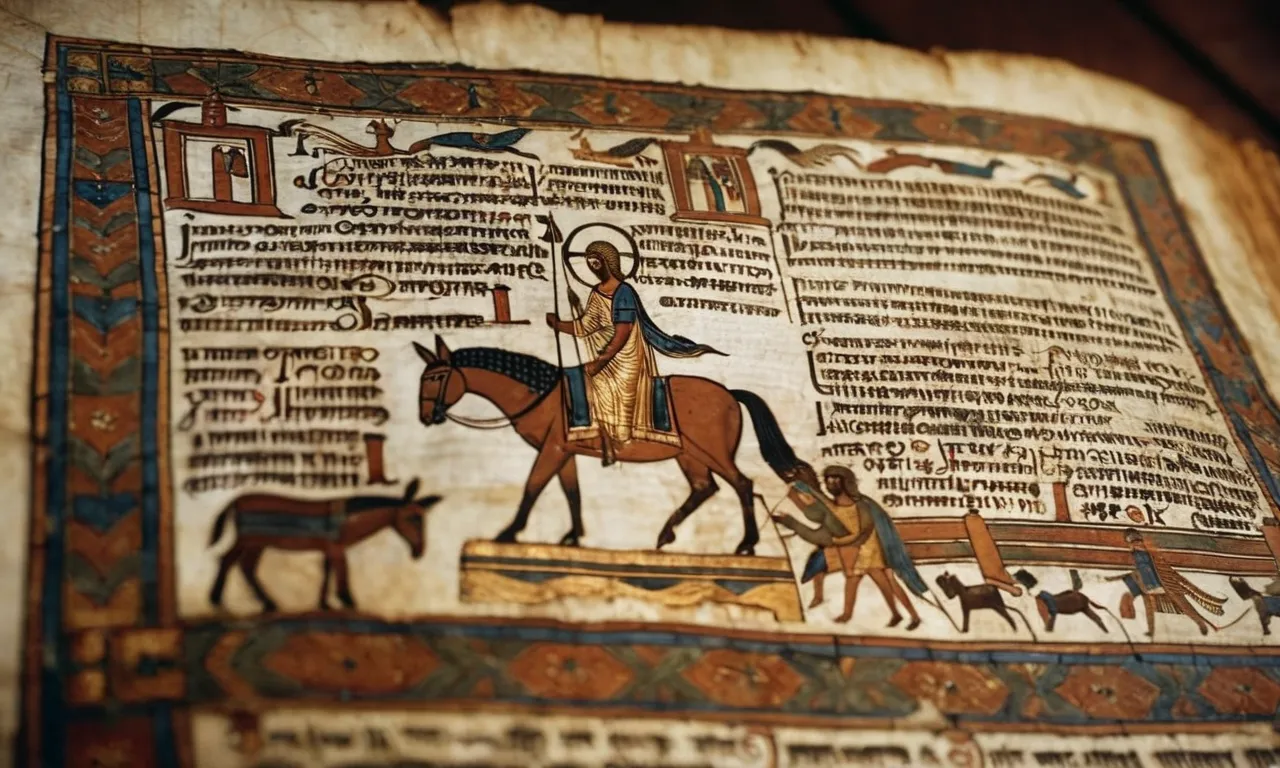Why The Bible Is Fiction: A Comprehensive Analysis
The Bible is one of the most influential texts in human history, with billions of followers worldwide. Yet many people question the veracity and validity of the stories contained within its pages.
If you’re wondering whether the Bible is fact or fiction, you’re not alone.
If you’re short on time, here’s a quick answer: the Bible contains many fictional stories, inconsistencies, and contradictions that point to it being a work of man’s imagination rather than divine truth.
In this comprehensive analysis, we will examine the evidence that shows the Bible is fiction rather than fact. We’ll look at the lack of historical and archeological evidence for key Biblical stories and characters.
We’ll highlight inconsistencies and contradictions within the Bible that point to it being written by different human authors with agendas rather than divine inspiration.
We’ll analyze the similarities between Biblical stories and older pagan myths.
And we’ll consider how the Bible portrays God in contradictory ways that defy logic. By the end, you’ll understand the multitude of reasons scholars and researchers have concluded the Bible is myth rather than history.
Lack of Historical and Archeological Evidence
No evidence for key characters
Many of the central figures found in the Bible have no evidence of their existence outside of the biblical texts.
The biblical Exodus, which describes Moses leading the Israelites out of Egypt and details their 40 years of wandering in the desert, has absolutely no corroboration from archaeological evidence.
Modern archaeologists have found no evidence to support the idea that millions of Israelites spent decades living in the desert.
There are also no records of the ten plagues described in Exodus being experienced by the Egyptians.
King David and his son King Solomon are described as ruling over a powerful united kingdom of Israel.
Instead, it reveals that at that time Canaan was occupied by many small, modest kingdoms.
Most significantly, there is a complete absence of any first century evidence that Jesus existed. There are no contemporaneous Roman records of his trial, crucifixion, or the miracles he is alleged to have performed.
The only records of Jesus’ existence come from the New Testament gospels which were written decades later by anonymous authors. The lack of any independent corroborating evidence is a major red flag for historians.
No evidence for major events
Many momentous biblical episodes such as the Exodus, the conquest of Canaan, and the united kingdom under David and Solomon are not supported by the archeological record.
These tales represent pivotal foundational history for the Israelites, and yet concrete evidence verifying these events is mysteriously missing.
The Exodus account describes epic plagues, death of Egyptian first-borns, parting of the Red Sea, mana from heaven, water from a rock, the Ten Commandments… yet none of this is evidenced in the Egyptian historical record.
There are no artifacts, inscriptions, or manuscripts chronicling any of these remarkable incidents.
Likewise, the biblical conquest portrayed in Joshua where the Israelites won great victories toppling Canaanite cities is not corroborated by archeology.
The excavated ruins show no signs of violent conquest and abrupt replacement of one culture by another during that period.
The archeological record also does not align with descriptions of the vast united kingdom under Saul, David and Solomon spanning from Dan to Beersheba (1 Kings 4:25).
Instead, the evidence points to many small modest kingdoms existing side-by-side.
The complete lack of hard evidence supporting these pivotal biblical episodes strongly indicates they are more likely mythological tales passed down through oral tradition rather than accurate historical accounts.
Inconsistencies and Contradictions
Differences across gospels
The four Gospels of the New Testament, though telling the same basic story of Jesus’ life, contain many discrepancies and contradictions in the details.
For example, the genealogies of Jesus in Matthew and Luke differ, with Matthew tracing Jesus’ lineage through Solomon but Luke tracing it through Nathan.
The birth narratives also conflict – Matthew has Joseph and Mary starting in Bethlehem, fleeing to Egypt, and later settling in Nazareth, while Luke has them start in Nazareth, travel to Bethlehem for the birth, and return to Nazareth.
Details surrounding Jesus’ death and resurrection also vary across the Gospels.
Mark and Matthew state that Jesus was crucified on the day after the Passover meal was eaten, while Luke states it was the day of Preparation before Passover.
The three Synoptic Gospels also give different details on the resurrection – Mark has Jesus meet the disciples in Galilee after the resurrection, Matthew depicts Jesus meeting them on a mountain in Galilee, while Luke has Jesus appear to them multiple times around Jerusalem.
Factual errors and inconsistencies
In addition to contradictions across Gospels, there are factual errors and inconsistencies within the Gospels themselves that bring their reliability into question.
For example, the Gospel of John depicts Jesus cleansing the temple near the start of his ministry, while the Synoptic Gospels describe this event happening in the final week of his life.
There are also historical inaccuracies – Luke states Joseph and Mary returned to Nazareth for a census under Quirinius, but there was no census at that time and Quirinius did not become governor of Syria until after Herod’s death.
Matthew’s Gospel portrays Herod slaughtering the innocent children in Bethlehem after Jesus’ birth, but there is no other record of this event outside the Bible.
Other inconsistencies include the Gospels giving different accounts of who discovered the empty tomb, how Judas died after betraying Jesus, and details surrounding Jesus’ post-resurrection appearances.
These errors indicate the Gospels were not written by eyewitnesses as is traditionally claimed.
Contradictory portrayals of God
The God of the Old Testament is often depicted quite differently from the God portrayed through Jesus in the New Testament. The Old Testament shows God frequently punishing wrongdoers and even ordering violence and warfare at times, while Christ preached a message of love, forgiveness, and peace.
For example, in Numbers 15, God commands the death penalty for working on the Sabbath, whereas Jesus broke strict Sabbath laws recorded in the Gospels without punishment.
The Old Testament depicts God wiping out humanity in a flood in Genesis and annihilating sinful cities with fire and brimstone in Genesis 19, contrasting starkly with Jesus’ message to turn the other cheek and love one’s enemies in the Sermon on the Mount (Matthew 5-7).
Such contradictory portrayals of God in the Old and New Testaments indicate the Bible was written by people with evolving views of God rather than by an omniscient, unchanging deity.
The humanity and imperfection underlying the Bible’s origins argue against it being divine revelation.
Similarities to Earlier Pagan Myths
Virgin Birth
The story of Jesus’s virgin birth has parallels in earlier pagan myths. Many ancient religions told of gods impregnating human women.
Mithras and Dionysus were also born of virgins. These myths cast doubt on the historical reliability of the virgin birth story in the Bible.
There is no firsthand historical evidence that Mary was a virgin. The virgin birth is only mentioned in the Gospels of Matthew and Luke, written 65-100 CE, while Mark and John make no mention of it.
The letters of Paul, written earlier around 50 CE, also do not reference a virgin birth.
This suggests the virgin birth was a later addition to Christian mythology, intended to compete with virgin birth stories of other religions.
Great Flood
The Genesis flood story has parallels with earlier flood myths from Mesopotamia. Tablets like the Epic of Gilgamesh describe a great flood sent by the gods to destroy humanity, with a righteous man saving animals on a boat.
Scholars believe the biblical authors adapted these older myths when compiling Genesis in the 6th century BCE. The earlier Sumerian flood tablet dates back to 2150 BCE.
Geologists have found no evidence for a global flood. Ice core samples show no sign of a mass extinction in antiquity. Dating methods also show human civilization continuing uninterrupted through the time the Genesis flood supposedly occurred.
This indicates the biblical flood story is mythological in origin.
Miracles
The miracles performed by Jesus appear influenced by earlier traditions about gods and heroes.
Pagan mythology told of gods healing the sick, multiplying food, walking on water, controlling the weather, and raising the dead. The legends of demigods like Hercules involve similar wondrous feats.
The miracles of Jesus seem to borrow from these well-known tales.
There are no eyewitness accounts of Jesus’s miracles. The miracle stories were passed down orally for decades before being written in the Gospels.
Their exaggerated nature and similarities to myths cast doubt on their historical accuracy.
Attempts to explain the miracles rationally, like Jesus walking on an ice patch over the Sea of Galilee, indicate they were not actual supernatural events.
Conclusion
In conclusion, a careful examination of the evidence shows the Bible is a work of fiction rather than fact. The lack of historical and archeological evidence for major characters and events paints the elaborate stories as myth rather than history.
The many contradictions and inconsistencies point to the Bible being authored over centuries by different writers with agendas.
Striking similarities to earlier pagan myths suggest the stories are not unique divine revelations but rather human creations.
Furthermore, the Bible’s illogical portrayals of God as unjust or exhibiting human limitations defy an all-knowing, just deity. While the Bible may contain wisdom, poetry, and allegory, the preponderance of evidence shows it is not the inerrant word of God.
The fictional nature of the Bible does not negate its cultural and personal significance for millions. But understanding its man-made origins is important for a fact-based evaluation of its contents.








